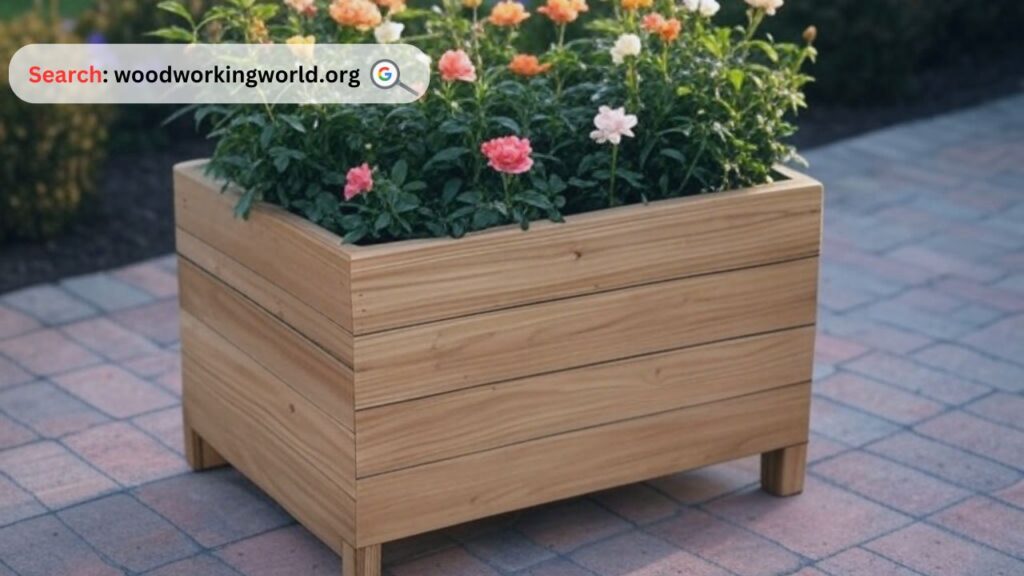Enhance your patio with a wooden rectangular planter! Discover stylish designs, DIY tips & top picks to transform your outdoor space. Click to learn more!
A patio is more than just an outdoor space; it’s an extension of your home where you can relax, entertain, and enjoy nature. Adding a wooden rectangular planter is one of the simplest yet most effective ways to elevate your patio’s aesthetics. These planters provide an elegant and functional solution for growing flowers, herbs, or even small vegetables, bringing life to your outdoor sanctuary.

Why Choose a Wooden Rectangular Planter?
Wooden rectangular planters offer a unique blend of style, functionality, and sustainability. Here are some key reasons why they make an excellent addition to any patio:
- Aesthetic Appeal – The natural look of wood blends seamlessly with any outdoor setting, enhancing the overall ambiance.
- Durability – When properly treated, wood can withstand weather changes, ensuring long-lasting use.
- Versatility – These planters are available in various sizes and can accommodate different types of plants.
- Eco-Friendliness – Many wooden planters are made from sustainable materials, making them an environmentally responsible choice.
- Customizability – You can easily paint, stain, or modify wooden planters to match your patio’s decor.
👉 Build 16,000+ Projects with Step-by-Step Plans—No Big Workshop or Costly Tools Needed! Start Now!
Step-by-Step Guide: How to Set Up a Wooden Rectangular Planter
Step 1: Choose the Right Wood
Not all wood types are suitable for outdoor use. The best choices for durability include:
- Cedar – Naturally resistant to rot and pests.
- Redwood – Offers longevity and a rich color.
- Teak – Highly durable and weather-resistant but expensive.
- Pressure-Treated Pine – Budget-friendly but may contain chemicals, so use a liner.
Step 2: Gather Your Materials
To build or assemble your wooden rectangular planter, you will need:
- Wooden planks (pre-cut to size)
- Screws or nails
- Drill or hammer
- Wood glue (optional)
- Sandpaper
- Liner (to prevent soil erosion and wood rot)
- Paint or sealant (optional for finishing)
Step 3: Assemble the Planter
- Prepare the Wood – Sand down any rough edges for a smooth finish.
- Build the Frame – Attach the wooden planks together to form a rectangular box using screws or nails.
- Reinforce the Corners – Use brackets or additional wood pieces to strengthen the structure.
- Attach the Bottom – Secure a wooden base, leaving small drainage gaps.
- Drill Drainage Holes – Prevent water buildup by creating holes at the bottom.
Step 4: Apply a Protective Finish
To extend the lifespan of your planter, apply a weather-resistant sealant or stain. This will help protect against moisture, UV rays, and insects.
Step 5: Add a Liner
A liner prevents direct contact between the soil and wood, reducing the risk of rot. You can use plastic sheeting, landscape fabric, or coconut fiber liners.
Step 6: Fill with Soil and Plants
- Choose high-quality potting soil for optimal plant growth.
- Consider the drainage needs of your plants.
- Arrange plants according to size and sunlight requirements.
Expert tips on Woodworking 🌿📦 Watch now!

Comparison Table: Wooden vs. Other Types of Planters
| Feature | Wooden Planter | Plastic Planter | Metal Planter | Ceramic Planter |
|---|---|---|---|---|
| Durability | High (with treatment) | Moderate | High | Fragile |
| Aesthetic Value | High | Moderate | Industrial Look | Classic |
| Eco-Friendliness | High | Low | Moderate | High |
| Customization | Easy to paint/stain | Limited | Difficult | Limited |
| Cost | Moderate | Low | High | High |
Tips to Maintain a Wooden Rectangular Planter
- Reapply Sealant Annually to maintain water resistance.
- Avoid Overwatering to prevent mold and rot.
- Keep it Elevated on bricks or stands to improve drainage.
- Clean Regularly to remove dirt and pests.
- Store Indoors in Harsh Weather to extend its lifespan.
Best Plants for a Wooden Rectangular Planter
Choosing the right plants depends on your climate and sunlight availability. Here are some great options:
- Flowers: Petunias, Marigolds, Geraniums
- Herbs: Basil, Thyme, Mint
- Vegetables: Lettuce, Cherry Tomatoes, Peppers
- Succulents: Jade Plant, Aloe Vera, Echeveria
“To plant a garden is to believe in tomorrow.” – Audrey Hepburn
Frequently Asked Questions (FAQ)
1. How long does a wooden planter last?
With proper maintenance, a high-quality wooden planter can last between 5 to 10 years.
2. Do I need to treat my wooden planter?
Yes, applying a wood sealant or stain helps protect against moisture and pests.
3. How do I prevent my wooden planter from rotting?
Using a liner, ensuring proper drainage, and applying a sealant will significantly reduce rot risks.
4. Can I paint my wooden planter?
Absolutely! Choose weather-resistant paint to enhance its look and longevity.
5. Should I drill drainage holes in my planter?
Yes, proper drainage prevents waterlogging and root rot.

Conclusion
Enhancing your patio with a wooden rectangular planter is an excellent way to add charm, greenery, and functionality to your outdoor space. By choosing the right wood, following a step-by-step setup process, and maintaining it properly, you can enjoy the benefits of a beautiful and thriving patio garden for years to come.
Whether you’re growing flowers, herbs, or vegetables, a well-designed wooden planter brings nature closer to home. So, roll up your sleeves and create a stunning outdoor oasis today!
👉 Click To Order Teds Woodworking With A 60-Money-back Guarantee From – Official Website